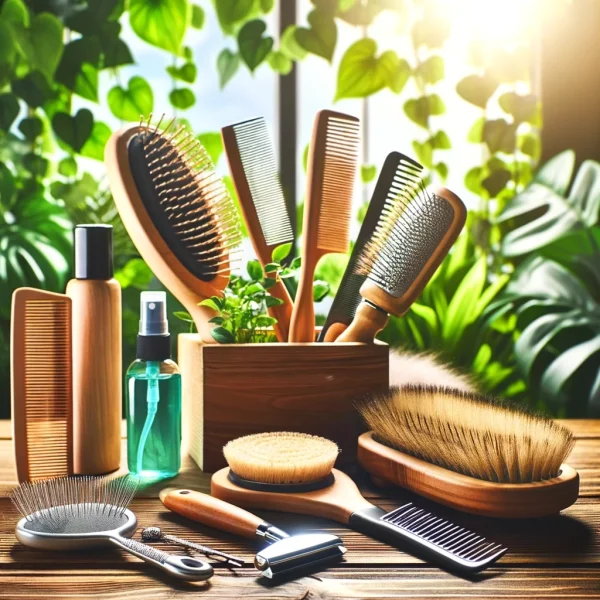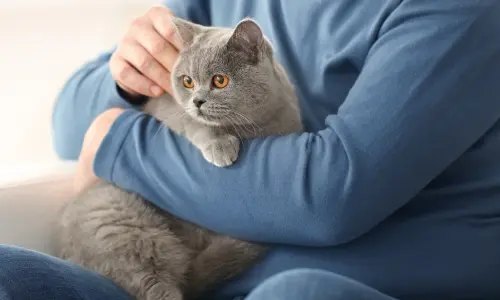Elevate your cat care routine with our guide to expert brushing techniques. Learn how to keep your feline's fur sleek and healthy today!
Caring for a cat involves much more than just providing food and love. Regular grooming, particularly brushing, is essential in implementing effective cat brushing techniques. These techniques play a pivotal role in maintaining your cat’s health and building a bond between you and your pet.
Whether you’re a seasoned cat owner or new to the world of feline care, understanding the right way to brush your cat is crucial.
Proper brushing not only keeps your cat’s coat gleaming but also helps to reduce hairballs, stimulate the skin, and distribute natural oils evenly across their fur.
In this guide, we’ll explore essential brushing techniques tailored to different types of cat fur. You’ll discover the best tools for the task and learn how to handle common challenges such as mats and tangles. By the end of this article, you will be equipped with practical skills to enhance your grooming routine, ensuring your cat remains healthy, happy, and well-groomed.
Let’s dive into the art of cat brushing and transform grooming from a chore into a delightful experience for both you and your furry friend.
Understanding Cat Fur Types
Different cats come with different grooming needs, largely determined by the type of fur they have. Knowing the specific characteristics of your cat’s fur can significantly influence how you approach brushing and overall grooming.
Here, we’ll explore the main types of cat fur—short, medium, and long—and discuss the specific care requirements for each to ensure optimal health and appearance.
Short-Haired Cats
- Characteristics: Short-haired cats have sleek, fine coats that are easier to manage than their longer-haired counterparts. Popular short-haired breeds include the American Shorthair and Siamese.
- Care Needs: Brushing once a week is typically sufficient to remove loose hair and distribute skin oils effectively. Use a soft-bristled brush or a fine-toothed comb to gently brush the coat.
Medium-Haired Cats
- Characteristics: Medium-haired cats, like the Classic Persian or Maine Coon, have more substantial fur that can sometimes be prone to tangling.
- Care Needs: These cats benefit from brushing several times a week with a pin brush or metal comb. Regular grooming helps prevent the formation of knots and keeps the coat shiny and healthy.
Long-Haired Cats
- Characteristics: Long-haired breeds such as the Siberian and the Norwegian Forest Cat have luxurious, thick coats that require the most grooming attention.
- Care Needs: Daily brushing is ideal for these cats to prevent matting and reduce shedding. A wide-toothed comb or a slicker brush works well to detangle and smooth out the fur without causing discomfort.
General Tips for All Fur Types
While the frequency and tools may vary, some brushing principles apply universally:
- Always be gentle to avoid pulling, which can cause pain and stress to your cat.
- Regular brushing reduces hairballs by minimizing the amount of hair ingested during self-grooming.
- Use brushing sessions as an opportunity to bond with your cat and check for any signs of skin problems or parasites.
- Understanding your cat’s fur type and adapting your grooming practices accordingly not only keeps your cat looking great but also contributes to their overall well-being. With the right approach, grooming can become a pleasurable activity that strengthens the bond between you and your pet.

Essential Brushing Tools
Choosing the right tools is crucial for effective cat grooming. Different brushes and combs are designed to handle various types of fur and grooming needs. Here’s an overview of the essential grooming tools along with recommendations for specific fur types, ensuring you select the best option for your feline‘s coat.
Brushes and Combs Overview
- Slicker Brushes: Ideal for removing knots and tangles, slicker brushes have fine, short wires close together on a flat surface. They are particularly useful for medium to long–haired cats to smooth the fur and remove loose hair.
- Bristle Brushes: Best for short-haired cats, bristle brushes have soft bristles that remove loose hair and stimulate the skin. This type of brush is excellent for distributing natural oils throughout the coat, enhancing shine and health.
- Pin Brushes: Similar to slicker brushes but with pins that are tipped with plastic or rubber, pin brushes are gentler than slicker brushes and are good for cats with medium to long fur that isn’t particularly prone to tangling.
- Metal Combs: Metal combs with wide-set teeth are great for untangling and smoothing out long-haired cats’ coats without pulling on the skin. They can also be used to remove dirt and debris from all fur types.
Recommendations for Specific Fur Types
- Short-Haired Cats: A rubber grooming glove or a soft bristle brush works well for weekly brushing. These tools are gentle and effective at catching loose fur and stimulating the skin.
- Medium-Haired Cats: Use a pin brush for regular grooming to help detangle and smooth the fur. A metal comb should also be used during grooming sessions to fine-tune areas where knots tend to form, such as under the armpits and around the neck.
- Long-Haired Cats: Start with a wide-toothed metal comb to gently detangle the fur, paying particular attention to common problem areas like behind the ears and beneath the collar. Follow up with a slicker brush to remove all the loose hair and prevent mats.
Additional Grooming Tools
- Detangling Sprays: These can be used alongside brushes and combs for cats with particularly tangled fur. They help smooth the fur and reduce static, making the brushing process easier and more comfortable for your cat.
- Flea Combs: Regardless of fur type, a flea comb is a useful tool for identifying and removing fleas from your cat’s coat.
Choosing the right grooming tools not only makes implementing cat brushing techniques more efficient but also more enjoyable for your cat. By matching the tool to your cat’s fur type, you ensure that grooming sessions using these techniques contribute positively to their overall well-being, keeping their coat in top condition while minimizing stress for both of you.
Step-by-Step Cat Brushing Techniques
Brushing your cat is not only essential for their coat health but also a great way to strengthen your bond. Each fur type requires a specific approach to ensure effective grooming while keeping the experience enjoyable and stress-free for your feline friend. Here’s a detailed guide on how to brush short, medium, and long-haired cats, along with tips to make grooming a positive experience.
Short-Haired Cats
- Step 1: Start with a rubber grooming glove or a soft bristle brush to gently remove loose fur. Use light strokes and follow the direction of the fur growth.
- Step 2: Focus on areas where shedding is heavier, typically the back and flanks.
- Step 3: Finish with a fine-tooth comb to catch any remaining loose hairs and smooth the coat.
- Tips: Keep sessions short, around 5-10 minutes, to maintain your cat’s interest and prevent any stress.
Medium-Haired Cats
- Step 1: Use a pin brush to detangle and remove loose hair. Begin at the head and work your way down to the tail, being gentle around sensitive areas like the belly and chest.
- Step 2: Address tangles and mats with a metal comb, working through them gently to avoid pulling the skin.
- Step 3: Regularly check for knots under the arms and behind the ears, areas prone to matting.
- Tips: Incorporate treats and soothing verbal praise to create a positive association with brushing.
Long-Haired Cats
- Step 1: Begin with a wide-tooth metal comb to gently work through any tangles, starting at the tips of the fur and gradually working closer to the skin.
- Step 2: Follow up with a slicker brush to remove loose fur and smooth the coat, being extra cautious to avoid scraping the skin.
- Step 3: Pay special attention to areas that mat easily, such as under the collar, behind the ears, and under the armpits.
- Tips: Make grooming a regular routine, ideally daily, to prevent mats from forming. Use detangling sprays if necessary to ease the brushing process.
General Tips for a Stress-Free Grooming Session
- Always brush in a calm, quiet environment to help your cat feel at ease.
- Speak softly and reassure your cat throughout the grooming session.
- Allow your cat to sniff and inspect the grooming tools before starting to help familiarize them with the equipment.
- Reward your cat with their favorite treat after each grooming session to end on a positive note, reinforcing good behavior.
- If your cat shows signs of stress or discomfort, pause the session and try again later. It’s important that grooming remains a positive experience.
By following these detailed brushing techniques and maintaining a gentle, patient approach, you can ensure that grooming is a pleasant, stress-reducing activity for your cat. This not only keeps their coat healthy and beautiful but also enhances the loving bond between you and your pet.

Dealing with Mats and Tangles
Mats and tangles can be uncomfortable for your cat, causing skin irritation and pain. Properly addressing these issues is crucial for maintaining the health and comfort of your pet. Here’s a guide on how to safely remove mats and tangles, and advice on when it might be time to seek professional help.
How to Safely Remove Mats and Tangles
Step 1: Identify the Problem Areas
Begin by gently petting your cat to locate any mats or tangles. Common areas include under the collar, behind the ears, and along the back legs.
Step 2: Use the Right Tools
For mild tangles, a wide-toothed comb or a detangling brush may be sufficient. For more stubborn mats, you might need a specialized dematting tool or mat splitter. Always use these tools cautiously to avoid pulling the skin.
Step 3: Hold the Base of the Mat
When working on a mat, hold the base of the fur closest to the skin with your fingers. This helps prevent pulling the skin while you gently tease the mat apart with your comb or tool.
Step 4: Work Gently
Work the mat gently from the outer edges inward, slowly loosening the tangles. If using a dematting tool, follow the direction of hair growth to minimize discomfort.
Step 5: Take Your Time
Patience is key. Work through the mat little by little, giving your cat breaks as needed. Never pull or cut the mat out with scissors as this can lead to cutting the skin.
When to Seek Professional Help
- Persistent Mats: If mats continue to form despite regular grooming, or if they’re too tight to remove safely, it’s time to consult a professional groomer. They have the skills and tools to remove severe mats without harming your cat.
- Signs of Skin Irritation: If you notice redness, sores, or any sign of skin irritation under the mats, it’s important to seek the help of a veterinarian. Mats can cause skin infections that might require medical attention.
- Behavioral Signs of Distress: If grooming sessions become too stressful or if your cat consistently resists brushing, professional groomers are not only equipped to handle difficult mats but also experienced in managing cats’ stress during grooming.
Maintaining a Mat-Free Coat
Preventing mats is easier than removing them. Regular grooming adapted to your cat’s fur type, as discussed in previous sections, is crucial. Ensure your grooming routine is consistent and gentle, and always keep an eye out for early signs of tangling.
By taking proactive steps to manage mats and tangles and knowing when to seek professional help, you can keep your cat’s coat healthy and beautiful, ensuring their comfort and well-being.
Maintaining a Regular Brushing Routine
Consistent grooming, using proper cat brushing techniques, is crucial for keeping your cat’s coat healthy, managing shedding, and preventing the formation of mats and tangles. Establishing and maintaining a regular brushing routine not only benefits your cat’s physical health but also strengthens your bond through regular, caring interaction. Here’s why employing these cat brushing techniques consistently is essential and how often you should brush different types of cat fur.
Importance of Consistency in Grooming
- Health Benefits: Regular brushing removes dirt, grease, and dead hair from your cat’s coat. It helps distribute the skin’s natural oils, which enhances the health and appearance of the coat. Brushing also stimulates the skin and improves blood circulation, contributing to a healthier, more vibrant coat.
- Reduces Hairballs: Cats groom themselves frequently and swallow hair in the process, which can lead to hairballs. Regular brushing reduces the amount of hair your cat ingests, thereby minimizing the occurrence of hairballs.
- Early Detection of Issues: A consistent grooming routine allows you to spot any abnormalities early, such as lumps, bumps, or skin infections. Early detection can lead to quicker interventions, which can be crucial for your cat’s health.
How Often to Brush Different Types of Cat Fur
- Short-Haired Cats: Short-haired cats generally require less frequent brushing since their fur does not mat or tangle easily. Brushing once a week is usually sufficient to keep their coat healthy and free of debris.
- Medium-Haired Cats: Medium-haired cats benefit from brushing two to three times a week. This helps prevent the formation of knots and keeps their longer fur glossy and smooth.
- Long-Haired Cats: Long-haired cats need the most frequent grooming. Daily brushing is recommended to prevent the formation of mats and tangles, which can become painful and difficult to manage if neglected.
Tips for Establishing a Routine
- Same Time, Same Place: Try to brush your cat at the same time and place to create a routine. This predictability helps reduce stress and makes your cat more comfortable with the process.
- Use Appropriate Tools: Ensure you use the right type of brush or comb depending on your cat’s fur type. Comfortable tools make the experience more pleasant for your cat.
- Positive Reinforcement: Make each grooming session enjoyable for your cat. Offer treats and affection to associate brushing with positive experiences.
- Patience and Gradual Introduction: If your cat is not used to regular grooming, introduce the routine gradually. Start with short sessions and gradually increase the duration as they become more comfortable.
By maintaining a regular brushing routine, you ensure your cat’s coat remains clean, tangle-free, and beautiful. Regular grooming sessions also serve as special bonding time, enhancing your relationship with your cat while keeping them in top health.
Proper grooming is an integral part of cat care
Proper grooming is an integral part of cat care that extends beyond mere aesthetics. It contributes significantly to their overall well-being, helps in the early detection of potential health issues, and enhances the bond between cats and their owners.
As we’ve explored in this guide, understanding the specific needs of your cat’s fur type and maintaining a consistent brushing routine are essential steps to ensure that your cat remains healthy, happy, and looking their best.
Brushing your cat regularly not only keeps their coat in excellent condition but also provides a special time for you and your cat to strengthen your relationship. The act of grooming is soothing for both the cat and the owner, fostering a sense of trust and comfort that enriches the companionship.
Remember, each cat is unique and may require adjustments to the general guidelines provided. Some cats might enjoy the brushing experience more than others, and some may take time to get accustomed to a regular grooming schedule. Patience and persistence are key when applying cat brushing techniques, as is the willingness to adapt these techniques and schedules to suit your cat’s preferences and behavior.
Conclusions
We encourage you to use the insights and techniques discussed in this guide to create a grooming routine that works for you and your cat. Whether your cat has short, medium, or long fur, the right approach to brushing can make a world of difference in their health and happiness.
Thank you for taking the time to learn about the best practices in cat grooming. With the right knowledge and tools, you’re now well-equipped to keep your feline friend’s coat shiny and healthy, ensuring they feel great and continue to bring joy into your life for years to come.
If you want to learn more about how to care for your cat, visit our blog.

